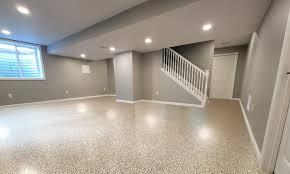Epoxy Floor for Basement: The Ultimate Guide to a Durable and Stylish Flooring Solution

If you’re searching for a flooring option that’s durable, moisture-resistant, and visually appealing, an epoxy floor for basement is one of the best choices you can make. Homeowners are increasingly turning to epoxy coatings to transform dull, cold concrete basements into beautiful, functional living spaces. Whether you’re using your basement as a gym, storage area, or entertainment room, epoxy flooring provides a seamless blend of strength, style, and practicality.
What Is Epoxy Flooring?
Epoxy flooring is a protective coating made from a mixture of epoxy resin and hardener. When applied to concrete, it creates a strong, glossy surface that resists water, stains, and impacts. This chemical bond forms a surface that’s not only visually appealing but also highly durable and long-lasting.
In basements—where moisture and temperature changes are common—epoxy floors provide a moisture-sealed surface that prevents water damage and mold growth.
Why Choose Epoxy Flooring for Your Basement?
Here are the top reasons epoxy floors are ideal for basement spaces:
1. Moisture and Mold Resistance
Basements are prone to dampness and humidity. Epoxy creates a waterproof barrier, preventing moisture from seeping into the concrete. This helps in reducing mold, mildew, and odor issues common in unfinished basements.
2. Durability and Longevity
Epoxy floors can withstand heavy loads, abrasion, and foot traffic without cracking or chipping. Once cured, the floor becomes harder than concrete, making it perfect for gym equipment, storage racks, or even vehicles if your basement has access.
3. Easy Maintenance
An epoxy floor is simple to clean. Its smooth, non-porous surface prevents dirt and spills from soaking in. All you need is a mop and mild cleaner to maintain a spotless, polished look.
4. Aesthetic Appeal
Epoxy coatings are available in various colors, finishes, and effects—including metallic, flake, and high-gloss options. You can customize your basement floor to match your interior design, turning it into a modern living space instead of a dull storage area.
5. Cost-Effective Solution
Compared to tiles or hardwood, epoxy is an affordable flooring option with long-term value. Its durability and low maintenance mean fewer repair costs over time.
Types of Epoxy Floors for Basements
There are several types of epoxy coatings suitable for basement floors:
1. Solid Color Epoxy
This is the most common and budget-friendly option. It provides a clean, uniform look and comes in a wide range of colors.
2. Metallic Epoxy Flooring
Metallic epoxy adds luxurious depth and shine to your basement. The metallic pigments create a 3D marbled effect, perfect for modern entertainment or office spaces.
3. Epoxy Flake Flooring
Flake epoxy includes decorative chips or flakes added between layers, giving the floor texture, traction, and aesthetic appeal. It’s great for basements that double as gyms or workshops.
4. Clear Epoxy Coating
A transparent coating enhances the natural look of concrete while adding protection and shine.
How to Install Epoxy Flooring in Your Basement
Installing an epoxy floor requires precision and proper preparation. Here’s an overview of the process:
-
Surface Preparation:
Clean the concrete thoroughly. Remove old paint, oil, or stains, and repair cracks to ensure a smooth base. -
Etching the Surface:
Etch or grind the concrete to open its pores for better epoxy adhesion. -
Applying the Primer:
Apply an epoxy primer to improve bonding and prevent air bubbles. -
Mixing the Epoxy Resin and Hardener:
Follow manufacturer instructions carefully—improper mixing can lead to peeling. -
Applying the Epoxy Coating:
Pour and spread the epoxy evenly using a roller or squeegee. -
Adding Decorative Flakes (Optional):
Sprinkle flakes while the epoxy is still wet to create texture and design. -
Sealing and Curing:
Apply a clear topcoat for extra durability. Let the floor cure for at least 48–72 hours before use.
Maintenance Tips for Epoxy Basement Floors
To keep your epoxy floor looking new for years:
-
Sweep regularly to remove dust and debris.
-
Clean spills immediately with mild soap and water.
-
Avoid dragging heavy furniture or metal objects.
-
Reapply a topcoat every few years to maintain gloss and protection.
Common Questions About Basement Epoxy Flooring
1. How long does epoxy flooring last in a basement?
With proper installation and care, epoxy floors can last 10–20 years or more.
2. Can epoxy floors handle basement moisture?
Yes. When applied correctly, epoxy acts as a moisture barrier, preventing water damage.
3. Is DIY epoxy flooring possible?
While DIY kits are available, professional installation ensures even coverage, adhesion, and durability.
4. Can epoxy floors be slippery?
Epoxy can be made slip-resistant by adding textured flakes or anti-slip additives.
Conclusion: Transform Your Basement with Epoxy Flooring
An epoxy floor for your basement is more than just a home improvement—it’s an investment in style, protection, and functionality. It enhances your space with a sleek finish, resists moisture, and lasts for decades with minimal maintenance. Whether you’re creating a home gym, office, or entertainment zone, epoxy flooring offers the perfect blend of beauty and resilience for your basement.
- Art
- Causes
- Crafts
- Dance
- Drinks
- Film
- Fitness
- Food
- Jocuri
- Gardening
- Health
- Home
- Literature
- Music
- Networking
- Alte
- Party
- Religion
- Shopping
- Sports
- Theater
- Wellness



